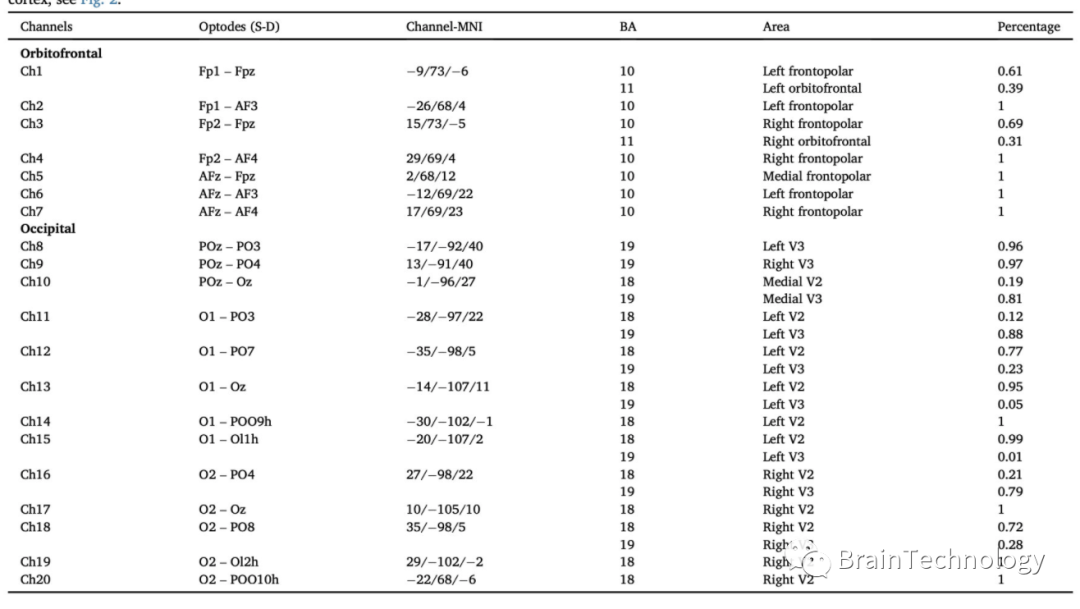1513 阅读 2020-07-30 11:55:02 上传
以下文章来源于 BrainTechnology
摘要
While word frequency and predictability effects have been examined extensively, any evidence on interactive effects as well as parafoveal influences during whole sentence reading remains inconsistent and elusive. Novel neuroimaging methods utilize eye movement data to account for the hemodynamic responses of very short events such as fixations during natural reading. In this study, we used the rapid sampling frequency of near-infrared spectroscopy (NIRS) to investigate neural responses in the occipital and orbitofrontal cortex to word frequency and predictability. We observed increased activation in the right ventral occipital cortex when the fixated word N was of low frequency, which we attribute to an enhanced cost during saccade planning. Importantly, unpredictable (in contrast to predictable) low frequency words increased the activity in the left dorsal occipital cortex at the fixation of the preceding word N-1, presumably due to an upcoming breach of top-down modulated expectation. Opposite to studies that utilized a serial presentation of words (e.g. Hofmann et al., 2014), we did not find such an interaction in the orbitofrontal cortex, implying that top-down timing of cognitive subprocesses is not required during natural reading. We discuss the implications of an interactive parafoveal-on-foveal effect for current models of eye movements.
虽然词频和可预测性效应已经被广泛研究,但是任何关于交互效应以及副中央窝在整个句子阅读过程中的影响的证据仍然是不一致和有争议的。新的神经影像学方法利用眼动数据来解释在短暂的事件中的血液动力学反应,例如自然阅读过程中的注视。在这项研究中,我们使用近红外光谱技术的快速抽样频率(NIRS)来研究枕叶和眶额皮质(前额脑区底部)对词频和可预测性的神经反应。我们观察到,当注视词 n 为低频时,右侧枕叶皮层的激活增加,我们认为这是由于在进行扫视时成本增加所致。重要的是,不可预测的(与可预测的相反)低频词语增加了左侧枕叶皮层在前面单词 N-1注视时的活动,可能是由于即将到来的自上而下调整期望的突破。相反的研究,利用一系列的单词呈现(例如 Hofmann 等人,2014年) ,我们没有发现这样的交互作用在眶额皮质(前额脑区底部),这意味着在自然阅读过程中认知过程的自上而下的时间安排是不必要的。我们讨论的影响交互式副中央窝对中央窝效应的眼球运动的当前模型。
实验设计

The experiment consisted of eight practice trials, as well as three blocks of 48 experimental trials each, separated by short breaks. At the beginning of each block, a three-point horizontal calibration was performed. Each trial started with a drift correction dot slightly left from where a sentence would appear. The context sentence was presented in a single line (font: Courier New, size: 18, visual angle < 0.33) until the participants pressed the ‘space’ bar. Followed by a short blank screen of 500 ms and another drift correction, a single line test sentence was shown, which contained the manipulated target word. After pressing ‘space’, a blank screen was presented, jittered between 2000 and 6000 ms. Randomly distributed between one third of all trials, multiple-choice comprehension questions with three possible answers were displayed, to which participants responded by pressing one of the buttons ‘1’, ‘2’ or ‘3’. After each question, a recalibration procedure was initiated, followed by the next trial. On average, the multiple-choice comprehension questions were answered with an accuracy of 95.93% (SD: 2.97%).
实验分为练习和正式实验两个阶段。练习8个试次,正式实验包括3个block,每个block 48个试次。实验开始实行三点校准,每个trial前进行单点校准,整个实验在记录被试眼球运动的同时,使用近红外设备记录眶额皮质和枕叶皮质的激活情况。
实验流程:单点校准后呈现“语境句”,被试阅读句子后按空格键,空屏(500ms),再次出现单点校准,呈现“检验句”,被试阅读句子后按空格键,空屏(2000~6000ms恢复基线)。
实验仪器:
Stabilized by a chin support, the participants were seated 70 cm away from a 2400 monitor. Movements from the right eye were recorded by an EyeLink 1000 Plus system (SR Research) at a sampling rate of 2 kHz. Simultaneously, changes of cerebral (de-)oxygenation were recorded by a NIRScout (NIRx) device at a sampling rate of 10.42 Hz. To capture the absorption spectra of [deoxy-Hb] and [oxy-Hb], the continuous wavelengths were set to 760 and 850 nm respectively. We used a 10-5 system cap with equidistant (3 cm) optode holders. Three sources and three detectors were attached above the nasion, resulting in seven channels to cover the OFC. Another set of three sources and nine detectors (forming 13 channels) recorded brain activity in the occipital cortex, focusing mostly on V2 and V3 (Table 2), while the interpolated activation map (see data analysis below) allowed a tentative analysis also in V1 (Fig. 2).
眼动仪:EyeLink 1000 Plus 2000hz
近红外:NIRX 10.42hz(6光源+12探测器)

近红外排布图:
实验分析结果:
近红外分析软件:NIRS-SPM
注视相关Fixation-related fNIRS data

笔者感悟:
这是发布在NeuroImage期刊上的文章,此多模态的结合能有效看到眼动+近红外的联合使用。这将给很多研究极大的推进。从技术层面来说,这两者的结合并不难,可以说非常容易,同时,它还可以完美的记录眼动过程与神经活动水平,这将是亮点。
参考文献:
Roelke,A., Vorstius, C., Radach, R., & Hofmann, M.J. (2020). Fixation-related NIRS indexes retinotopic occipital processing of parafoveal preview during natural reading. NeuroImage. https://doi.org/10.1016/j.neuroimage.2020
文章下载:https://sci-hub.tw/https://www.sciencedirect.com/science/article/pii/S1053811920303104
更多相关多模态EyeTracking+NIRS的研究:
Kita, Y., Gunji, A., Sakihara, K., Inagaki, M., Kaga, M., Nakagawa, E., & Hosokawa, T. (2010). Scanning Strategies Do Not Modulate Face Identification: Eye-Tracking and Near-Infrared Spectroscopy Study. PLoS ONE, 5(6), e11050. doi:10.1371/journal.pone.0011050
Kita, Y., Gunji, A., Inoue, Y., Goto, T., Sakihara, K., Kaga, M., … Hosokawa, T. (2011). Self-face recognition in children with autism spectrum disorders: A near-infrared spectroscopy study. Brain and Development, 33(6), 494–503. doi:10.1016/j.braindev.2010.11.007














